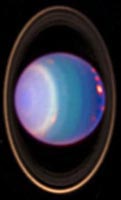|
URANUS
A
recent Hubble Space Telescope view above reveals Uranus surrounded
by its four major rings and by 10 of its 17 known satellites
(click to enlarge). This false-color image was generated
by Erich Karkoschka using data taken on August 8, 1998, with Hubble's
Near Infrared Camera and Multi-Object Spectrometer. Click
here for more.
This
is a view of Uranus taken by Voyager 2 from behind the planet (click
to enlarge). The image was taken through three color filters
and recombined to produce the color image. Click
here for more.
The
above two pictures of Uranus -- one in true color (left) and the
other in false color -- were compiled from images returned Jan.
17, 1986, by the narrow-angle camera of Voyager 2
(click to enlarge). The spacecraft was 9.1 million kilometers
(5.7 million miles) from the planet, several days from closest approach.
The picture at left has been processed to show Uranus as human eyes
would see it from the vantage point of the spacecraft. The darker
shadings at the upper right of the disk correspond to the day-night
boundary on the planet. Beyond this boundary lies the hidden northern
hemisphere of Uranus, which currently remains in total darkness
as the planet rotates. The blue-green color results from the absorption
of red light by methane gas in Uranus' deep, cold and remarkably
clear atmosphere. The picture at right uses false color and extreme
contrast enhancement to bring out subtle details in the polar region
of Uranus. Click
here for more.
|


